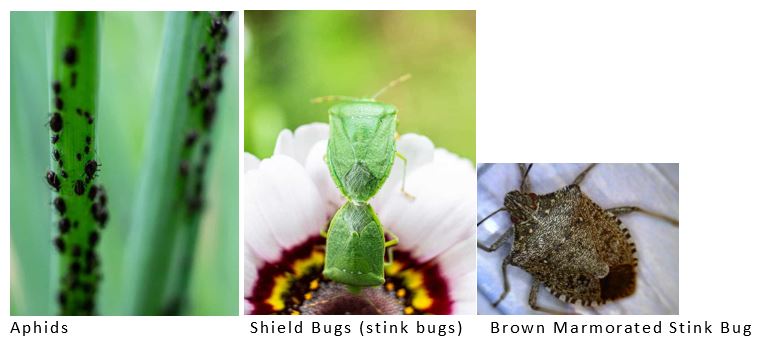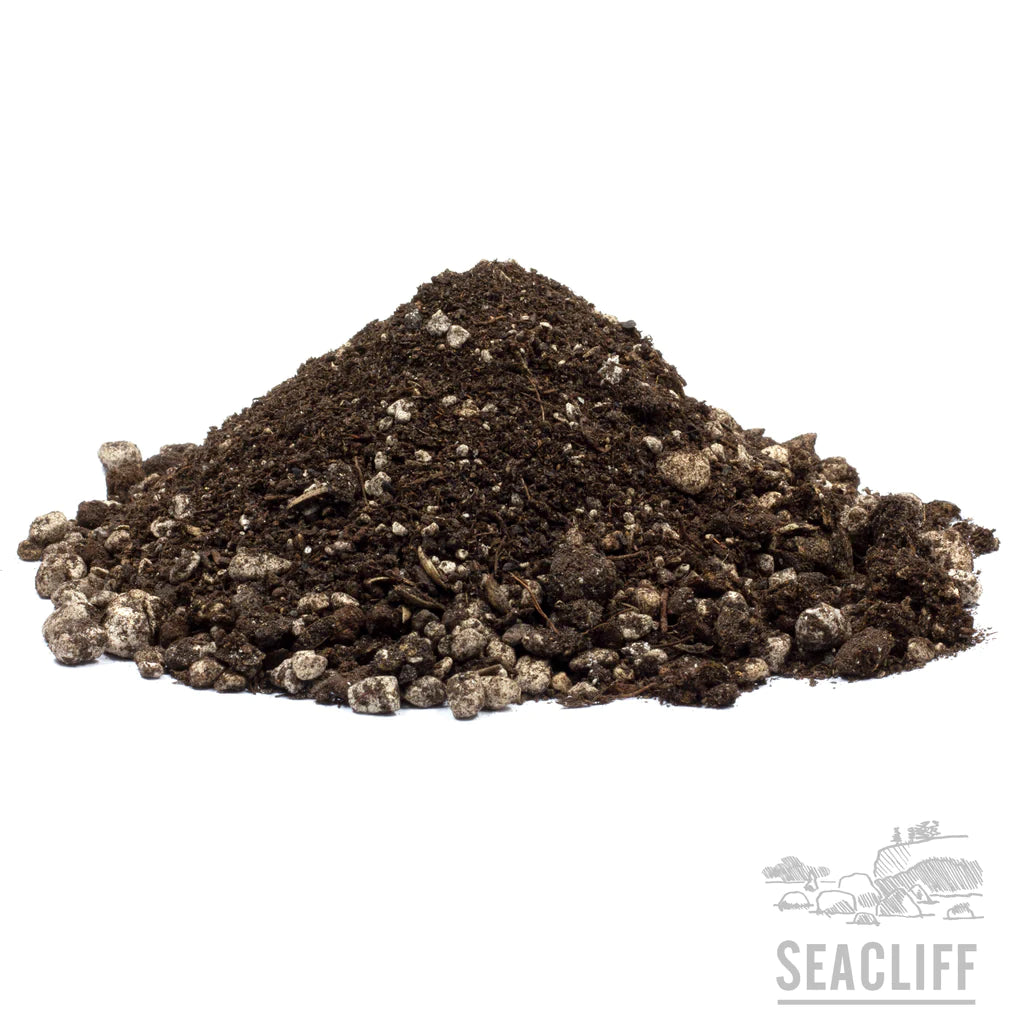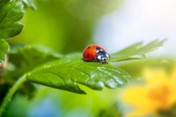
Those Pesky (or not?) Bugs
Information from "Insects In The Garden - Homegrown Happiness".
Insects in the garden are important, both the 'bad' and the good play a crucial role in a well-rounded eco system. However it's helpful to know which are pests and which are not, so that we can keep the pest numbers under control.
Especially if you're gardening organically, dealing with pests early is the best way to stay on top of things. It's helpful to be able to distinguish between the eggs of the pests and of the beneficial insects in the garden so we don't get rid of the good guys.
Keeping a close eye on your plants especially the underside of leaves is the best way to keep on top of bug infestations. If you catch them before the eggs hatch you are stopping hundreds of bugs from destroying your garden (or for the good bug eggs you leave behind, you're employing your own bad-bug busting crew).
APHIDS
These pests come in a variety of colours, grey, yellow, green, brown... Some have a shiny coat whilst the mealy grey cabbage aphid has a more powdery appearance.
They'll suck the sap from your plants and stunt the plant's growth, attract ants, plus in some cases the sticky substance they leave behind (called honeydew) causes sooty mould.

SHIELD BUGS (Stink Bugs)
These guys stink literally and figuratively! Their eggs are easy enough to identify as they are usually made in a pretty geometric pattern. That's all that's positive about these insects though. We have a few types in NZ and they cause a lot of hidden damage to our fruits and vegetables. You won't always know until you bite into an apple or a tomato that the stink bug has been there.

If you see stink bug eggs, removing them ASAP is an effective control. The adults can be manually picked off and the soil around the affected plants can be sprinkled with diatomaceous earth. There is one specific type of stink bug that NZ Ministry of Primary Industries (MPI) is desperately trying to keep out of NZ.
It would do unthinkable damage to our fruits and vegetables here and they are nearly impossible to keep under control if established here. It's called the brown marmorated stink bug and if you see spot it in your garden, please catch it and call MPI immediately!
Marmorated Stink Bug

LADYBIRDS
Most ladybirds are beneficial in the garden as they'll eat your aphids.
However, the eggs and larvae below belong to the Harlequin ladybird which is not a native to NZ. Though the harlequin ladybird does eat aphids, it also preys on native insects and can be a pest to certain fruit crops.
Harlequin Ladybird larvae
A really beneficial ladybird is called the Mealybug ladybird and this one deals to mealybugs as well as scale! It's only found in warmer Northland NZ though as it doesn't like cold winters. The larvae are sometimes hard to tell apart from the actual mealybug.
MEALYBUGS

An annoying sapsucker, mealybugs can leave a sticky honeydew mess which will stunt plant growth, attract ants and sometimes cause sooty mould.
From far away mealybugs look like white powder on your plants. Mealybugs can be sprayed with a homemade soap spray or a neem oil spray.
SCALE

Sapsucking scale can come in a few different colours and looks like those sucking molluscs stuck to rocks at the beach. They have a hard shell so they're pretty resistant to any sprays.
Picking them off is an effective way to deal to them and it helps to catch them early to avoid dealing with a big infestation. Alternatively the infested plant can be sprayed with a neem oil spray which the scale will then ingest.
Mealybug ladybird larvae
WHITE BUTTERFLY (Cabbage Moth)
These yellowy white eggs may be hard to spot but the telltale sign is that they'll be on your brassicas.
Once the caterpillars hatch they eat quickly and efficiently at your prized veg. They like to hide on the stem of the leaf when they're bigger.
The eggs can be wiped off the leaves and bigger caterpillars can be picked off. However this can get way too tedious, or near impossible if you have a large crop. Netting is your best bet to control the caterpillars, or spray with organic caterpillar biocontrol.

PSYLLID
In NZ we have the tomato/potato psyllid (Bactericera cockerelli.) It's a jumping fly louse but their nymphs look similar to scale only smaller. These bugs are sapsuckers but they also transmit a devastating plant disease into our potatoes and tomatoes called Liberibacter.
Tomatoes and potatoes become stunted, discoloured (yellowing, brown spots) and deformed. A telltale sign is a dusting of white 'psyllid sugar' on the leaves, which is the sap they suck, dried up. Spraying adult pysllid is hard because they'll fly away but nymphs can be sprayed with neem oil.
The fine bug cloth can keep out these pests.
Psyllid

THRIPS
Thrips suck sap from the plants and cause silvering and discolouration of leaves and fruit, particularly citrus fruit. They can be sprayed with neem oil. Thrips can overwinter even if all the affected leaves from the tree drop off. Spray the affected trees in winter with a horticultural oil to smother any eggs hiding in the tree crevices.

LACEWING
Here is another good guy! Lacewings are excellent aphid controllers. They lay their teeny eggs in little cocoons and have them hanging off spider webs, plant hairs or whatever they find that works.
Lacewings breed all year round and usually lay their eggs close to an infestation of aphids.
Two lacewing eggs on comfrey (plus an aphid)

PASSION VINE HOPPERS
They lay their eggs over autumn, on dead wood, in little lines. If they’re on plants, cut off the wood and throw it in the bin, in a tightly sealed plastic bag, or burn them. If it’s on your stakes or trellis, scrape a knife down the edge to squish the eggs. This should reduce the number of these pests in summer.
Once spring and summer come, the best method to control their numbers is to vacuum them up! You can spray with a homemade soap spray or neem oil but they’re so fast, they usually just hop away before you can hit them. Using a handheld vacuum is a satisfying and successful method.

SPIDER MITES
Spider mites (also known as garden mites), including European red mite, two spotted spider mite, cyclamen mite and clover mite are very tiny pests (less than 1mm) that chew through leaves leaving a speckled appearance and pale leaves. They are so small they are only just visible to the naked eye. The red colour of the red spider mite and clover mite makes them a little easier to see. Under a lens it can be seen that they have eight legs and resemble a very small spider. They are members of the Arachnida class which include spiders.

Spider mites often produce webbing as protection from predators and this is a sign of infestation.
Spider mites can be difficult to control. Infested leaves later harden and become pale and bronzed. Under favourable conditions, mite populations build up rapidly. Early recognition and action are essential if you are to avoid problems. Mites are most active when conditions are warm and dry. It is a regular pest of many plants indoors but can also infest berry fruits, roses, fruit trees.
Otaki Hydroponics sells a product called Mitey Mite, which is effective against spider mites, but oils and sulphur sprays are also available.


